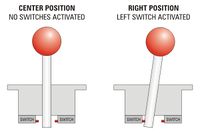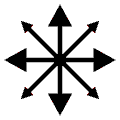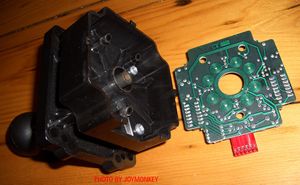Joysticks
Contents
Conventional Digital Joysticks
Conventional joysticks are fairly simple devices without which Pac-Man would be ghost-fodder. When the joystick shaft is moved in any direction, the lower end of the stick is levered in the opposite direction and makes contact with switches, these switches are what tells Pac-Man to move and in which direction.
By using four switches at the base of the joystick, 8 directions can be achieved; Up, Down, Left and Right as well as the four corner positions. Joysticks like this are known as 8-way.
Some joysticks were designed to restrict the player from moving diagonally; for example, joysticks used in Pac-Man and Donkey Kong. Though it is possible to use an 8-way joystick for these games, it's not recommended, as accidentally hitting a diagonal with the joystick will cause Mario to stand still and Pac-Man won't know if he should go up or to the side. Joysticks like this are known as 4-way.
Other games, such as Defender, Joust, Mario Brothers and Galaga, used a 2-way joystick since movement was only necessary from left to right or up to down.
Standard 8-way only joysticks:
Standard 4-way only joysticks:
- Happ Ms.Pac/Galaga Reunion, Betson Ms.Pac/Galaga Reunion, Happ Ultimate (can be ordered in 8 way, 4-way, or 2-way models,Wico 4-Way Leafswitch (discontinued).
8-Way to 4-Way Switchable Joysticks
Many 8-way joysticks that are sold can also be set to work in 4-way mode. There are two basic methods to change modes:
1) Changing a restrictor plate that only allows the joystick handle to be pushed in certain directions; or:
2) Changing the actuator (that's the small piece on the bottom end of the joystick shaft that makes contact with the switches) to only allow contact with one switch at a time.
Restrictor plate changes convert the joystick to "true" 4-way operation, and will give the best play. Actuator changes do not keep the handle from moving into the diagonal positions, this method only keeps the switches from being activated. The result is a "dead spot" in the corners, where the stick can be pushed, but no switches are hit. This is not much better than playing in standard 8-way mode, and is not reccomended. Adjusting these joystick usually involves opening up your control panel so you can access the lower section of the joystick base. Some models using a restrictor plate can be easily changed by hand once the control panel is open, while some others require the use of basic tools, like a screwdriver.
Joysticks that can be set to 4-way or 8-way operation via an actuator swap include:
Joysticks that can be set to 4-way or 8-way operation via the restrictor plate include:
- Suzo 500 (aka Euro-Stik or Omni-Stik), Ultimarc T-Stik, Ultimarc Mag-Stik, Ultimarc J-Stik, Sanwa JLF-TP-8YT, Seimitsu LS-32.
In the last few years, some companies have added to this feature to allow the joystick to be switchable from above the control panel in some way. This makes it simple for anyone to switch the joystick between 4-way to 8-way from game to game, without having to access 'the guts' of the control panel.
Conventional joysticks that can be switched from above the control panel like this include:
Non-Conventional Digital Joysticks
Suzo Inductive Joystick
Instead of using the conventional microswitches, Suzo Inductive sticks use a magnet at the base of its shaft that is read by eight 'pads' on its PCB. It is completely silent and easily switchable between 4-way and 8-way using a pot under the joystick.
Happ Perfect 360 (P360)
49-Way Joysticks
Once used in a small handfull of Williams, Midway and Atari games, 49 way joysticks live in a no-man's land between digital and analog joysticks. 49-way joysticks do not, as the name might seem to imply, point in 49 different directions. The number 49 comes from the number of positions the stick can report to the game hardware, including positions somewhere between "dead center" and "pushed all the way". Imagine a 7x7 grid (that's 49 squares) and you've got it. Games that originally used this hardware benefited from the extra info the joystick could report by allowing the player to control the on-screen character with more precision- both in the form of better directional control (24 discrete directions possible, if you count dead center), and 3 levels of speed control, based on how far from center the stick was pushed. For example, in SiniStar, the player can make the ship move faster or slower, by varying how hard they push the stick, and the ship's movement is not limited to just 8 directions. Attempting to play this game (or others that originally used 49-way sticks) with a standard 8-way digital joystick tends to be frustrating- SiniStar is a very difficult game in the first place; take away the speed control and limit yourself to 8 directions, and it's really, really hard. More info on 49-way joysticks can be found at What are 49-Way joysticks? by URebelScum
Games that originally used 49-way joysticks include:
- SiniStar
- Blaster
- Arch Rivals
- Pigskin 621 A.D.
- Blitz
- Blitz '99
- Blitz 2000
- NFL Blitz 2000 Gold Edition
- NBA Showtime
- SportStation
- Gauntlet: Legends
- Gauntlet: Dark Legacy
For home gaming purposes, when paired with the GP Wiz49 controller from [www.groovygamegear.com GroovyGameGear], these analog style joysticks have become a popular all-around stick. Using the GP-Wiz's various DRS modes, these joysticks can be easily switched between 8-way, 4-way, 2-way (vertical), 2-way (horizontal) and diagonal (Q*Bert style) modes without having to physically change the joystick hardware. This allows these sticks to be used to play any digital joystick games well. In additon, the two 49-way modes allow play for games that originally used 49-way sticks (and have emulator support that goes beyond 8-ways- not all 49-way games do), and also will play well for some games that originally used analog or Hall-Effect joysticks.
Analog Joysicks
Analog joysticks are not bound by the limits digital joysticks face. Digital joysticks can only point in 8 (or fewer; see above) directions, or no direction at all (centered). Analog joysticks can point in (theoretically) an unlimited number of directions. Furthermore, Analog joystics can discern how far the handle has been pushed from the center position. Games take advantage of these properties to give the player a much greater level of control over their on-screen character. For example, the bird in Road Runner can run in more than just the 8 standard directions, and how far the player pushes the joystick from center determines how fast the Road Runner runs.
Most analog sticks use a pair of potentiometers, one to measure left-to-right movement (the X-axis), and one to measure forward-and-back movement (the Y-axis). A few games, however, used a "Hall Effect" stick. Hall effect sticks use Hall sensors and magnets to read the postion of the stick. The end result is the same, though- both types report to the game which direction and how far the stick is being pressed.
While the actual resolution of an analog joystick may be theoretically unlimited, the standard for analog joysticks connected to a PC is 256x256. Compare this to the 7x7 resolution of a 49-way joystick, or the 3x3 resolution of a standard 8-way joystick. This explains why it is difficult to play games that originally used analog controls with a standard 8-way stick; the stick simply can't control the on-screen character the way it was intended to be controlled. A 49-way stick is sufficient for some games that originally used analog controls, but not all of them. Road Runner, for example, can be adequately controlled with a 49-way joystick, as that stick would give the bird 24 directions to run in, and four speeds (including stopped)- which ought to be enough to outwit that dumb coyote. Star Wars, on the other hand, cannot be played well with a 49-way, as that stick will only aim the X-Wing's blasters at 49 equally spaced spots on the screen, leaving Tie Fighters that are in-between those spots un-shootable. (Star Wars actually used an analog Flight Yoke, rather than an analog joystick, but these controls are electrically identical, and actually interchangeable as far as the game is concerned.)
Games that used analog joysticks include:
|
|
|


